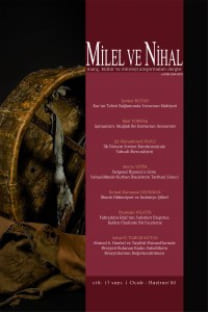İbadet, Ritüel ve Kurban
Dinsel amaçlarla yerine getirilen özel davranışlar din araştırmalarında“ibadet” olarak tanımlanır. Pagan gelenekler açısından bu tür davranışlar“ritüel” kelimesiyle ifade edilir. Şekilsel açıdan bu iki kavram kıyaslandığındaibadet ile ritüelin benzer davranış şekillerini yansıttığı görülür. Ancakİslami bir kavram olan ibadet ile paganist geleneeğin ürünü olan ritüelistik davranış arasında manevi düzlemde büyük bir farklılık söz konusudur.Ritüelistik davranışta insanın tanrı ile mekanik bir ilişkisi ve menfaatedinme kaygısı söz konusudur. İbadet ise mümin bireyin yaşamıboyunca sürdüreeceği rabbine karşı kulluk bilincinin bir parçası olarak anlamkazanmıştır. Dolayısıyla ritüel, tanrıya dönük, dönemsel ve karşılıklıçıkar ilişkisine dayalı bir ilişkiyi tanımlarken İslami anlamda ibadet ahiretsaadeti peşindeki müminin rabbine kul olma bilincinin davranışa yansımışhalini ifade etmektedir.
Anahtar Kelimeler:
İbadet, ritüel, kurban, trajedi, Kierkegaard
Worship, Ritual and Sacrifice
In religion studies, special behaviors and actions that are performedwith religious objectives are defined as ‘worship’. In Paganist traditions,these actions and behaviors are expressed as ‘ritual’. When these two conceptsare compared from a formal point of view, both worship and ritualexhibit similar forms of behavior. However, there is a great difference onthe spiritual level between the Islamic concept of worship and the ritualisticbehavior of the paganist tradition. In ritualistic behavior, human being hasa mechanical relationship with God and is concerned with obtaining benefits.While worship is defined as a lifelong commitment of a believer toGod, that is backed by a servitude mindset and consciousness. Therefore,while ritual defines a relationship that is god-oriented, periodic and basedon mutual interest, Islamic sense of worship expresses the consciousness ofbeing a servant of the God by the believer, in the wake of the Hereafter.
Keywords:
Worship, ritual, sacrifice, tragedy, Kierkegaard,
___
- E. M. Zuesse, “Ritual”, Encyclopedia of Religion (New York: Macmillan, 1987).
- Victor Turner, Forest of Symbol (Ithaca: Cornell University Press, 1967).
- Jan N. Bremmer, Greek Normative Animal Sacrifice, A Companion to Greek Religion, ed.: D. Ogden (Oxford: Blackwell, 2007).
- R. M. Ogilvie, The Romans and their Gods (London: Hogarth Press, 1986).
- Ingvild Sælid Gilhus, Animals, Gods and Humans (London: Roudletge, 2006).
- Detienne, M. and J.-P. Vernant (eds), The Cuisine of Sacrifice among the Greeks (Chicago: University of Chicago Press, 1989).
- P. Garnsey, Food and Society in Classical Antiquity (Cambridge: Cambridge University Press, 1999).
- Kevin J. Wetmore, Jr., The Athenian Sun in an African Sky: Modern African Adaptations of Classical Greek Tragedy (London: McFarland & Company, 2002).
- Sarah Dewar-Watson, Tragedy: A Reader’s Guide to Essential Criticism (London: Palgrave Macmillan, 2014).
- Walter Burkert, Greek Tragedy and Sacrificial Ritual (Duke University, 1966).
- Understanding Religious Sacrifice: A Reader, ed.: J. Carter (London: Continuum, 2006).
- Walter Burkert, “Ritual in Ancient Greece”, Savage Energies: Lessons of Myth and Ritual in Ancient Greece, tr. P. Bing (Chicago: University of Chicago Press, 2001).
- Soren Kierkegaard, Korku ve Titreme, tr. İ. Kapaklıkaya (İstanbul: Anka, 2002).
- Rağıb el-İsfahanî, Müfredât: Kur’an Kavramları Sözlüğü, tr.: A. Güneş, M. Yolcu (İstanbul: Çıra Yayınları, 2012).
- Mustafa Sinanoğlu, “İbadet”, TDV, İslam Ansiklopedisi, c. 19, 1999.
- Fahruddîn er-Razî, Tefsir-i Kebîr: Mefâtîh’ul-Gayb, tr. S. Yıldırım vd. 4. Cilt (Ankara: Akçağ, 1989).
- ISSN: 1304-5482
- Yayın Aralığı: Yılda 2 Sayı
- Başlangıç: 2003
- Yayıncı: Milel ve Nihal: Eğitim, Kültür ve Düşünce Platformu Derneği
Sayıdaki Diğer Makaleler
Dâvûd Kayserî’de Valık, Bilgi ve İnsan
Tanrılaştırma ve Şeytanlaştırma Arasında Mitolojik Bir Figür Olarak Asklepios
Ulemanın Siyaseti: İran’da Ulemanın Etkin Rolünü Anlamak
Hakan Olgun, Tuz ve Işık: Hz. İsa’nın Dağ Vaazı
“Küresel Kentte Karşılaşmalar” (ya da) Yeni Bir Nomos Olarak Şiddet/Terör
Sâmiriler: Köken Sorunu ve Günümüz İsrail Devletinde’ki Yansımaları
İslam Toplumlarında Şiddet Yanlısı Radikalleşme Nedenleri Üzerine Bir İnceleme
